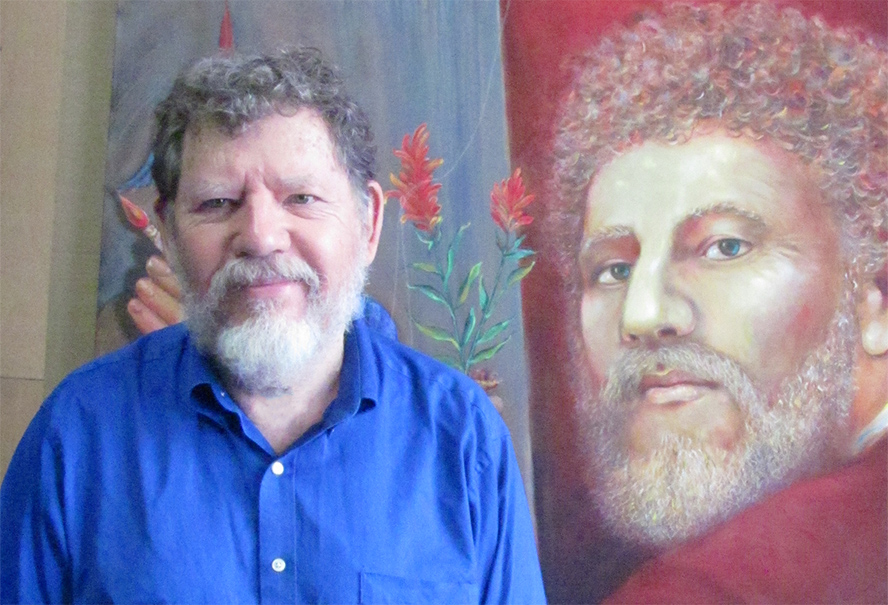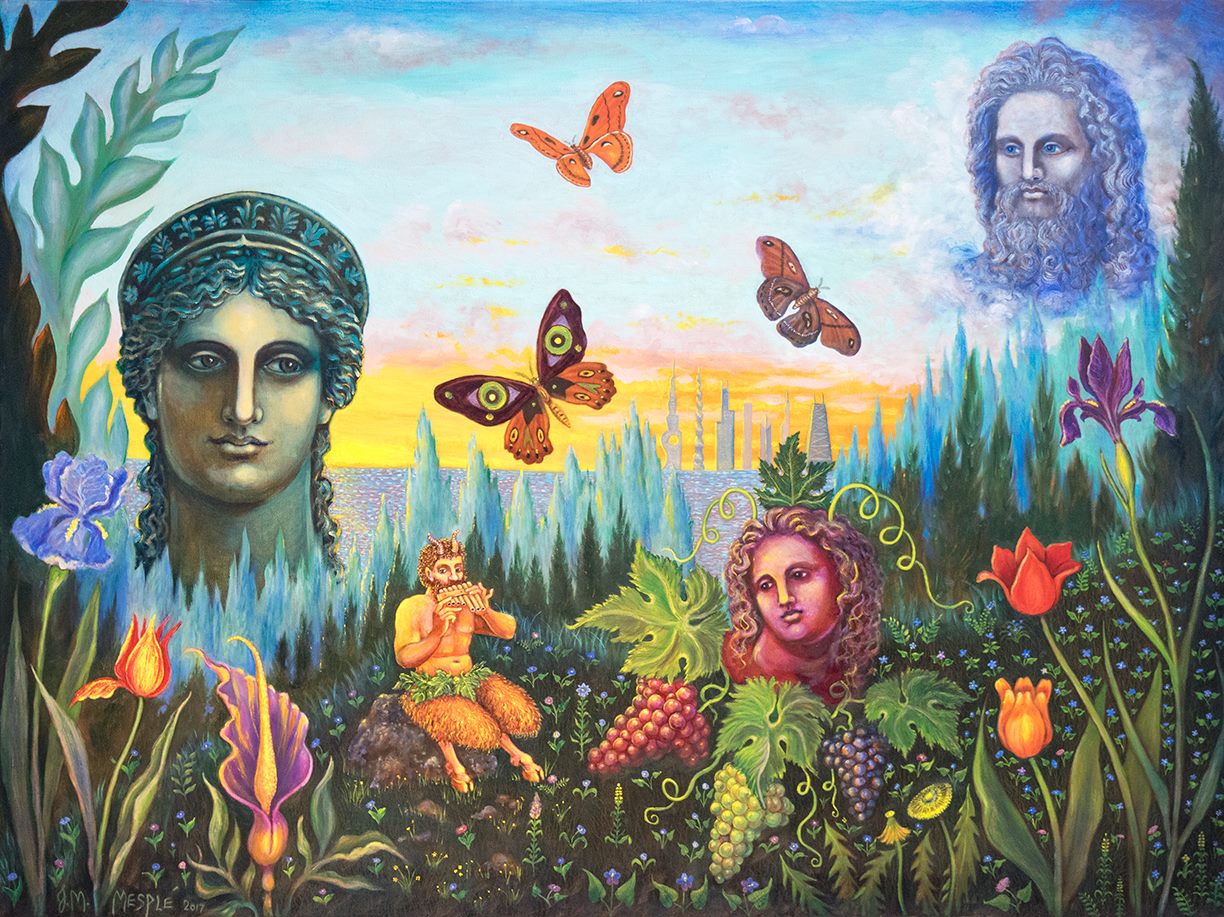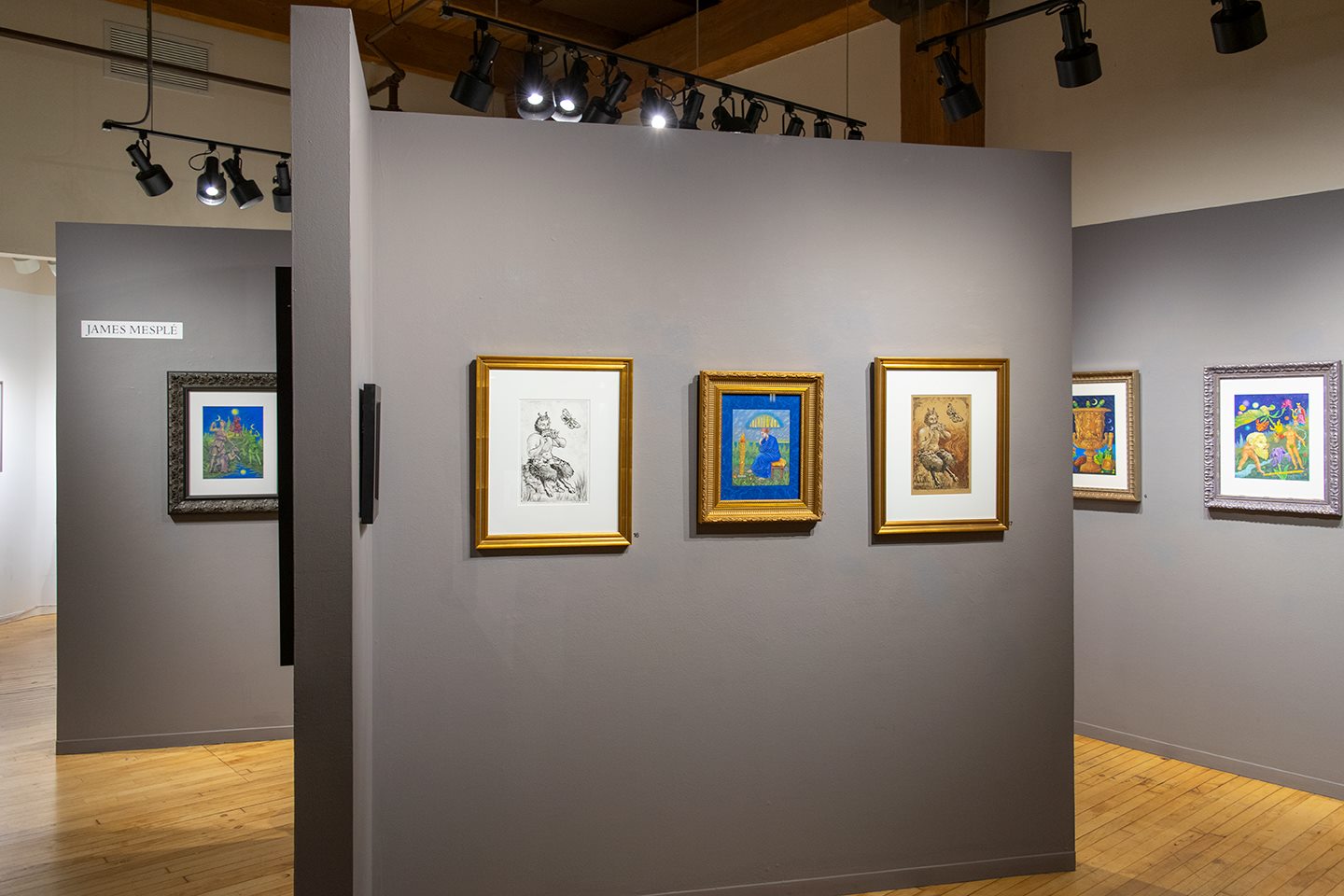Artist Insights: James Mesple


By CGN Staff
Following a busy end-of-year crammed with deadlines and to-dos, we are pleased to be getting back to sharing news and features with CGN readers as we await the arrival of our 2019 CGN Arts Guide in the coming days.
First up is the return of the Artist Insights series, in which we ask various artists a set of questions about their practice as well as local favorites. We recently spoke with James Mesplé, a charming figure in the Chicago art community, who has been a regular visitor to the CGN office for years, always taking time to stop in and share his own book, film and art show recommendations with us.
Mesplé’s vibrant work features signature imagery that links to the past through figures from history and literature.
Mesplé studied painting at the University of Missouri, and after graduation he moved to Chicago in 1968 and eventually graduated with honors from Northeastern Illinois University in 1970. He has taught art at various Chicago institutions over the years, including Francis W. Parker School, and the School of the Art Institute of Chicago.
Mesplé lives and works in Chicago. His most recent show from November 2018, Arcadia, was the final exhibition to take place at Printworks Gallery. He also shows his art at Jackson Junge Gallery in Wicker Park.
Tell us a little about your hometown?
I come from the Missouri Ozarks, from a small town called Nevada near Neosho and Joplin Missouri. It's in the southwest part of the state where Missouri, Kansas, Oklahoma, and Arkansas meet.
Previous occupations?
My first job was a summer job with the Chicago Tribune, which was followed by ten years of teaching art at the Francis Parker School in Lincoln Park. And then at the Studios of the School of the Art Institute of Chicago. I also conducted various workshops in watercolor and egg tempera at the Oxbow Artists’ Retreat in Michigan, as well as at the University of Chicago and Northwestern University.
Favorite spot to spend time in the city.
A toss-up between the Art Institute of Chicago and the Field Museum
Preferred art store.
Artist and Craftsman Supply on South Wabash and Blick Art Materials on North Avenue. (I need both, since Pearl Art & Craft Supplies left River North years ago.)
Favorite Music?
I play woodwinds, so I often take a break from painting and pick up my flute to play Vivaldi, or if I want a longer break, I soak a reed and play Mozart or Beethoven on bassoon, etc. But while I’m working on a painting, I listen to classical music.
In the summer, l like the free concerts at Millennium Park with the symphony or I go listen to the free string quartet at the Cultural Center.
Coffee or tea?
Coffee during the day, but at night, herbal tea – especially if I have detailed work to do and need control; chamomile tea is calming and makes the hand steady.
Tell us a little about your training?
I studied both music and art at the University of Missouri for two years (bassoon and painting). I transferred to Northeastern Illinois (Chicago) and finished my undergraduate degree there. I began teaching art at Francis Parker and attended SAIC at the same time, receiving a continuing education certificate while making my own art on weekends and having exhibitions of my art in theater lobbies, or wherever I could show it.
What art has been particularly meaningful in your life?
I have done printmaking, ceramic sculpture, and even jewelry making, but my first love has always been painting.
Trips to Europe to see the world’s great collections of paintings were something I worked hard to make happen over and over. It was really a continuing part of my education. A painter must see paintings to learn from them. Trips to Italy, France, Spain, Germany, and Great Britain are a must for a painter – or get to the Art Institute of Chicago, the Metropolitan Museum of Art in New York and the National Gallery in Washington if you can’t go to Europe.
What was the first work of art to make a lasting impression on you?
I attended Benton Grade School in Nevada, MO. In the front hall of the school was a large color reproduction of Thomas Hart Benton’s painting in the Truman Library in Independence, Missouri. I passed it every day from first through sixth grade. My high school art class went on an all-day trip to see the Truman Library, and this is when I learned that the 36-inch color reproduction in Benton Grade School was nothing like the massive wall mural Benton had painted in the library. This was a revelation. Years later, at the University of Missouri, I got to meet Thomas Hart Benton and was exposed for the first time to the technique 'mixed' (which combines egg tempera and oil).
Whenever I visit my sister, who lives in Independence, I try to visit his mural. Even after seeing many of the major art museums in Europe, the mural still fascinates me.
Describe your studio.
There are several easels, because I work on several paintings at the same time. I have a north light, a table to mix or grind pigments, a life-sized copy of Venus de Milo for inspiration, and a cabinet for my paints.
How do you know when a piece is finished?
I know it’s finished when it says to me “I’m alive.” If a work doesn’t sell right away, I often keep refining it, sometimes for years. I have also experienced seeing my sold works in someone’s home years later and I would have changed some small thing – unfortunately then it is no longer possible.
Any tricks for getting past a creative block?
I’ve never had a creative block. If I did, I would immediately consult my sketch books, which have hundreds and hundreds of sketches with my “ideas” that I will never have enough time to develop into a painting. To do them all would take a dozen lifetimes.
You have three minutes in an art store to take whatever you want, what do you grab?
I would take a tube of genuine vermilion paint or a fine sable brush (which wouldn’t work well for me, because art stores keep both items locked up!)
What should we expect to see from you next?
After finishing Arcadia at Printworks Gallery, which was an exhibition of small works on paper, I am looking forward to working on a new series of large paintings on canvas and panel. They will continue my interest in Contemporary Classics and the world of mythology.








